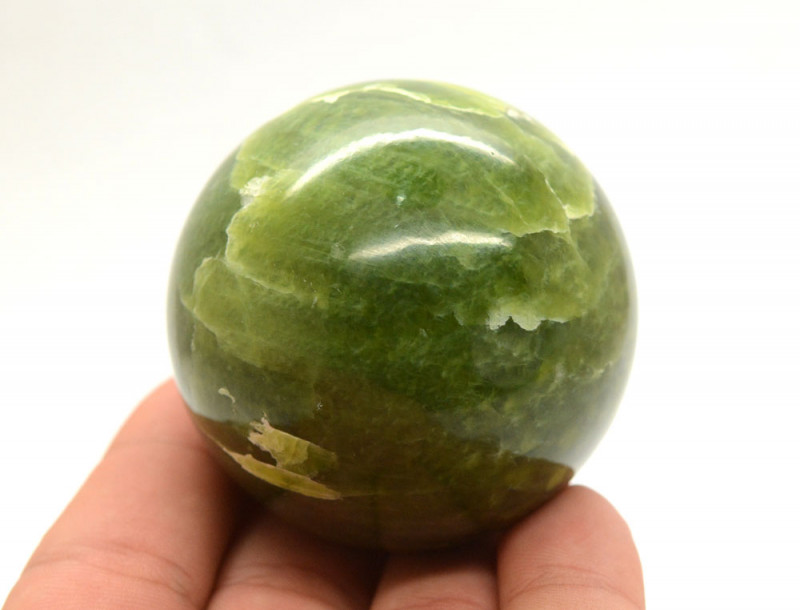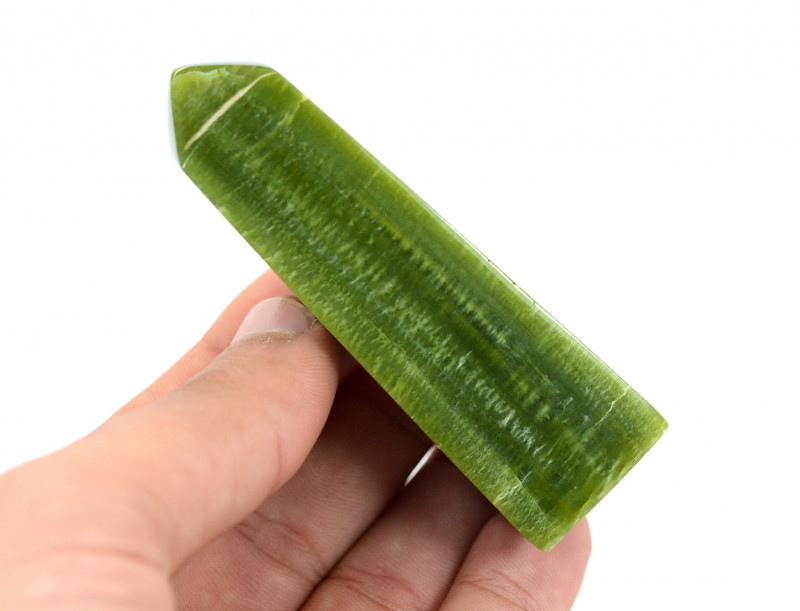Tremolite Gemstone: Properties, Meanings, Value & More
 Tremolite is a fibrous amphibole mineral related to actinolite. What color is tremolite? Usually, it’s white or green, but it can also be pink, lilac, yellow, gray, or brown.
Tremolite is a fibrous amphibole mineral related to actinolite. What color is tremolite? Usually, it’s white or green, but it can also be pink, lilac, yellow, gray, or brown.
Is tremolite rare or common? As a mineral, tremolite is common. However, gemstones are rare because tremolite doesn’t form facetable crystals often.
Still, tremolite’s optical properties and colorful varieties set it apart. In this guide, we'll cover tremolite’s properties, varieties, healing uses, and more!

About Tremolite Stone
Tremolite is a glassy to silky gem sometimes called “grammarite.” It’s a zodiac stone for Gemini, Libra, Scorpio, and Pisces.
This stone is one of the five amphibole asbestos minerals, along with crocidolite, anthophyllite, amosite, and actinolite.
Though it can be used as a semi-precious gemstone, industrial tremolite uses are more commonly known. The mineral lent well to various applications because it:
Resists heat
Doesn’t conduct electricity
Dampens sound
Insulates
Prevents corrosion
With that in mind, what is tremolite used for? Former uses include:
Insulation
Paint
Roofing
Plumbing
Sealants
Textiles (fibers can be woven)
Why former uses? Tremolite is a type of asbestos. Asbestos, including tremolite asbestos, is banned for its toxicity.
Don’t worry, though! We’ll discuss more about safe handling later.
Tremolite Specifications & Characteristics
Tremolite is a calcium magnesium iron silicate in the amphibole group. It forms a series with actinolite and ferroactinolite, representing the magnesium-dominant end. Ferroactinolite is the iron-dominant end, while actinolite is in the middle.
What is the difference between actinolite and tremolite? Tremolite has more magnesium than iron, while actinolite has more iron than magnesium.
That said, actinolite and tremolite are closely related and hard to differentiate. Iron can replace some magnesium in tremolite, making it closer to actinolite’s composition.
Tremolite can form flattened or bladed crystals, along with fibrous, columnar, or granular aggregates. Internally, tremolite’s structure is made of thin, flexible fibers, which may be interlocked, sheaf-like, or radiating.
Here are tremolite’s properties:
Mohs hardness: 5-6
Color: White, colorless, gray, brown, shades of green, light yellow, pink, lavender
Crystal structure: Monoclinic
Luster: Vitreous (glassy) or silky
Transparency: Transparent to opaque
Refractive index: 1.56-1.64
Density: 2.95-3.20
Cleavage: Perfect on [110]
Fracture: Uneven or splintery
Streak: White
Luminescence: Fluorescence in hexagonite - Orange to yellow or greenish-white in SW-UV; Orange, pink to pinkish-red, or dull yellow in LW-UV
Pleochroism: Hexagonite - deep reddish-violet, deep rose, and bluish-red; Green Tanzanian crystals - Pale yellow-green, light green, and green
Optical effects: Sometimes chatoyancy
Birefringence: Weak; 0.017-0.027; Hexagonite - 0.019-0.028
Types of Tremolite
Tremolite has two official varieties and three stones it may appear in, all of which we’ll discuss below.
Chrome Tremolite
Chrome tremolite is a rare, chromium-rich variety with a lime- to emerald-green hue caused by chromium. Rough crystals are often thumbnail specimens.
Hexagonite
Hexagonite is the rarest variety. This transparent, pink, lilac, or purple tremolite is rich in manganese and sometimes called “purple tremolite.”
The hexagonite name was a mistake, as the mineralogist originally thought it had a hexagonal crystal system.
Byssolite
Byssolite is a green to turquoise, fibrous amphibole entirely or partly composed of tremolite or actinolite.
It occurs as fibrous masses or needle-like crystals. Notably, byssolite and chrysotile create the valuable “horsetail” inclusions in demantoid.
Cat’s Eye Tremolite

Cat’s eye tremolite displays chatoyancy (the “cat’s eye” effect). When cut correctly, parallel tremolite fibers inside reflect a light ray down the stone’s center.
These stones can be green, dark blue, or brown.
Like byssolite, cat’s eye tremolite is sometimes composed of actinolite. Either way, many sellers call the stone “cat’s eye jade,” but is jade a tremolite? Sometimes, yes!
Nephrite Jade

The two jade stones, nephrite and jadeite, are actually metamorphic rocks used as gems. Like the last two, nephrite jade can be composed entirely or partly by tremolite or actinolite. Tremolite jade gems are very durable, composed of dense, interlocking tremolite fibrous bunches.
Tremolite nephrite is usually pale yellowish-white. The mineral can also occur as inclusions in nephrite, creating white bands called “water lines.”
Witch’s Finger
Lastly, witch’s finger is a nickname for quartz containing inclusions of mica, rutile, white tremolite, and green actinolite. Most come from Zambia.
This unique crystal has a shape resembling a finger with warts. That may not seem super appealing, but witch’s finger crystals are often starbrary quartz. Starbrary crystals have naturally etched grooves that look like ancient hieroglyphs.
Speaking of the ancient and mystical, next up is tremolite’s symbolism and past!

Tremolite Meaning & History
Tremolite symbolizes peace, fulfillment, and harmony. Witch’s finger tremolite is said to hold ancient wisdom, while hexagonite is used for spiritual growth.
The first name for tremolite was “säulenspath” (German for “columnar spar”) in 1782. Hungarian mineralogist Johann Ehrenreich von Fichtel chose the name after finding specimens in Transylvania, Romania.
The current name “tremolite” honors Switzerland’s Tremola Valley. This name came from Johann Georg Albrecht Höpfner, a Swiss pharmacist and writer, in 1789.
Höpfner got his specimens from a dealer who claimed they came from Tremola Valley. However, modern scientists discovered tremolite’s true first source was a dolomite marble in Campolungo, Switzerland.
In 1797, French mineralogist René Just Haüy named the entire mineral group “amphibole” after the Greek term amphibolos, for “ambiguous.” He chose this term because the minerals in this group at the time — tremolite, actinolite, tourmaline, and hornblende — had widely varied appearances and properties.
On that topic, let’s look at the different healing properties of tremolite and its varieties!

Tremolite Healing Properties
You can use gems as healing stones based on their coloring and internal vibrations. White tremolite joins other white crystals in representing spiritual awareness, purification, and inner peace.
Green tremolite, like other green gemstones, brings luck, vitality, and balance. These green crystals are heart chakra stones, opening the chakra for self-love and openness.
Now, what are tremolite’s physical and emotional benefits?
Physical Healing
Physical tremolite crystal benefits are said to include:
Treating heart diseases or illnesses
Boosting the immune system
Enhancing vision
Emotional Healing
Emotionally, tremolite is purported to reduce melancholy and increase happiness. Crystal healers use it for promoting contentment, self-esteem, and resilience.

Tremolite Gemstone Properties
Tremolite’s value as a gemstone comes down to the standard properties: color, cut, clarity, transparency, and carat weight.
Color
Tremolite is often creamy white or light green, but it can be gray, brown, or purple. Its varieties also introduce pink, gray, and yellow. Darker brown or gray hues are often caused by graphite inclusions.
Tremolite’s green hues mostly come from varying levels of iron impurities, with more iron meaning greener coloring. However, chrome tremolite is colored by chromium, vanadium, or both.
Purple hues in hexagonite come from manganese impurities. Light gray or white tremolites are low in iron.
Saturated colors, especially rare purple or emerald-green hues, are most valuable.
Cut
Tremolite is rarely faceted, making faceted options quite valuable. Cat’s eye tremolites must be cut as cabochons. Other tremolite cuts include carvings, towers, and spheres.
Nephrite is often carved, with higher value for greater intricacy. Otherwise, it’s typically cut en cabochon and occasionally faceted.
Clarity & Transparency
Clarity represents the visible inclusions in a gem. Tremolite is usually an inclusion in other gems like quartz or emerald. Still, tremolite may contain inclusions itself, like graphite, calcite, chlorite.
One faceted hexagonite studied by the Gemological Institute of America (GIA) contained iridescent cleavage cracks (from thin air films sneaking in) and needle-like inclusions.
No visible inclusions means better transparency, so tremolites with good clarity and high transparency are best.
Carat Weight
Transparent, colorless tremolite crystals are difficult to find, even small ones. The biggest examples without extreme fractures are 5-10 carats. Tanzania produces the largest, facetable tremolites.
Faceted chrome tremolite is also small, and faceted hexagonites have only reached around 1 carat. The largest cat’s eye tremolite is a brown, 12.55-carat Canadian stone.

Tremolite Formation & Sources
Tremolite forms when sediments rich in calcium and magnesium undergo contact metamorphism.
Contact metamorphism happens when a rock becomes heated by magma nearby, transforming the rock and minerals inside. In tremolite’s case, it often starts as diopside.
What is tremolite found in? Typically, miners find tremolite inside metamorphosed carbonates like dolomite marbles, greenschists, and skarns.
Mining Locations
The best tremolite (including chrome tremolite) currently comes from Tanzania, though Kenya is also significant for gem-quality specimens. New York, USA, produces the only facetable hexagonites and many chrome tremolites. Ontario, Canada, is significant for cat’s eye tremolite.
Other tremolite sources include:
Afghanistan
Austria
Australia
China
Finland — chrome
France
Germany
Italy
Myanmar — cat’s eye
Norway
Sierra Leone — high-quality chrome
Switzerland
USA (Arizona, California, Colorado, Connecticut, Massachusetts, South Dakota, Utah; North Carolina - chrome)
Finally, let’s discuss tremolite’s price!

Tremolite Price & Value
Faceted tremolites, especially chrome or hexagonite, and high-quality cat’s eye tremolite are the rarest and priciest.
Cat’s eye tremolite ranges from $3-$20. Similarly polished, larger freeform pieces are around $20-$25.
Looking at carvings, tremolite spheres range from $20-$30. Towers usually fetch around $15-$20, though ones mixed with serpentine can be around $50.
Rough tremolite specimens are $4-$16 per carat at wholesale. Raw, transparent crystals are pricier, around $100 each.
Hexagonite rough is usually $11 to $250, or $0.03-$0.50 per carat. Raw crystals with bright coloring are pricier, reaching $1,200.
Lastly, we’ll go over proper tremolite gemstone care.
Tremolite Care and Maintenance
First, is tremolite safe? It depends. Asbestos is toxic when inhaled, so the biggest risk comes with rough specimens. Because fibers or powder won’t come off polished pieces, these are safe. Regardless, always wash your hands after handling tremolite.
Jewelry-wise, tremolite aggregates are more durable and wearable than crystals. The stone is also heat-sensitive. Keep it away from direct heat and store it in a cool environment.
To clean tremolite, rinsing it with lukewarm to cool water should do the trick. Practice extra safety with a mask and gloves.
Treat Yourself to Tremolite!
Tremolite can come in gorgeous, polished specimens and carvings, perfect for lifting your spirits. Whether you like bright greens and pinks or muted grays and whites, there’s a tremolite for you!
Was this article helpful?
Ross Sedawie
- Written - 24th Jul 2022
- Edited - 1st Aug 2023






![11.01 CTS RARE TREMOLITE SPECIMEN -TANZANIA [S7575 ]](https://liveplatforms-production.b-cdn.net/tenants/gr/uploads/images/295000-299999/298735/298735_1349932861.jpg?width=480&aspect_ratio=1001%3A1000&auto_optimize=medium)
![10.56 CTS RARE TREMOLITE SPECIMEN -TANZANIA [S7576 ]](https://liveplatforms-production.b-cdn.net/tenants/gr/uploads/images/295000-299999/298738/298738_1349932948.jpg?width=480&aspect_ratio=1001%3A1000&auto_optimize=medium)
![7.92 CTS RARE TREMOLITE SPECIMEN -TANZANIA [S7579 ]](https://liveplatforms-production.b-cdn.net/tenants/gr/uploads/images/295000-299999/298744/298744_1349933189.jpg?width=480&aspect_ratio=1001%3A1000&auto_optimize=medium)







